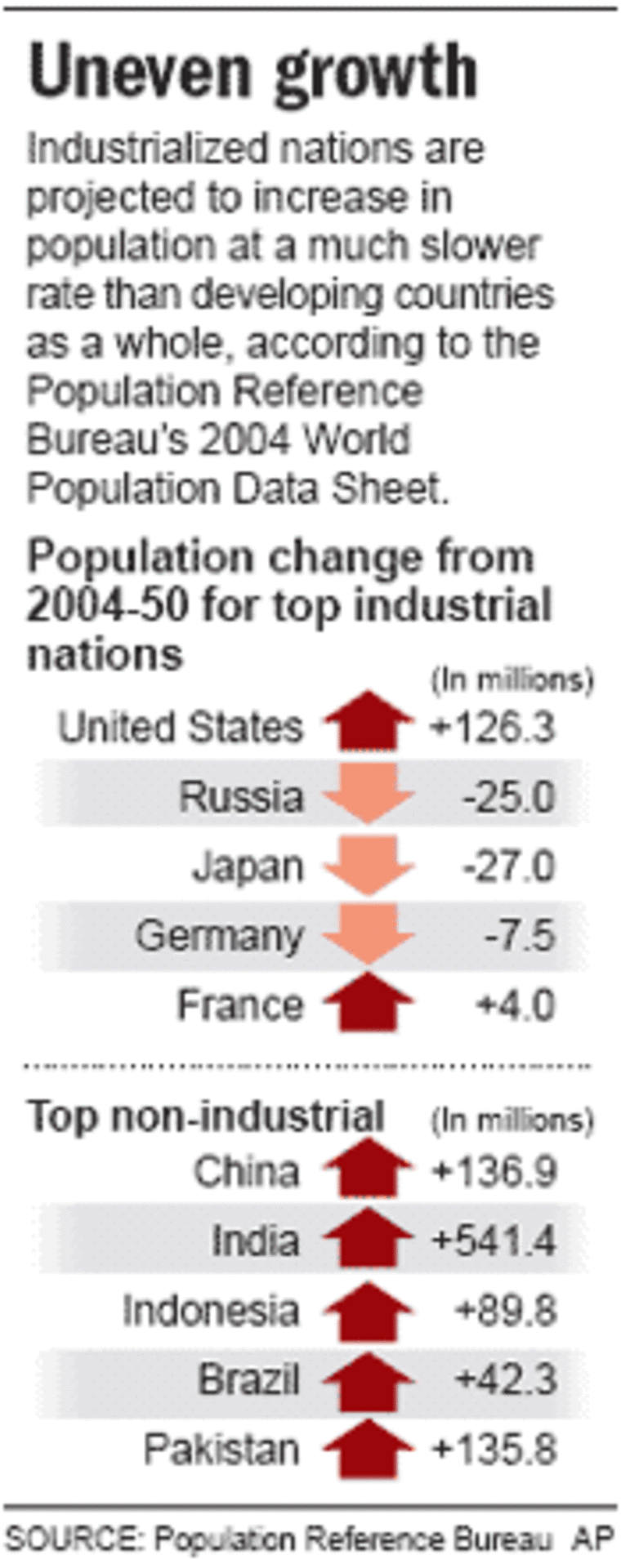Many of the world’s largest industrialized nations will lose population between now and 2050 as low birth rates, struggling economies and curbs on immigration stifle growth, says the author of a world population report.
The annual study by the private Population Reference Bureau found that, while the world’s population will increase nearly 50 percent by mid-century, Japan will lose 20 percent of its population in the next 45 years, while Russia, Germany and Italy will also see declines.
The United States is the biggest exception among developed countries, with its population forecast to rise by 43 percent from 293 million now to 420 million at mid-century.
Still, most of the world’s population growth will come in developing nations, even though these less developed countries generally have much higher rates of HIV and AIDS infections and infant mortality.
China, currently the world’s most populous nation at 1.3 billion, would see an overall 10 percent increase between now and 2050 to over 1.4 billion in 2050, but its peak population is anticipated to be reached by 2025 with declines thereafter.
India expected to top China
By 2050, India is expected to overtake China, rising almost 50 percent from under 1.1 billion now to 1.6 billion at mid-century. Nigeria’s population is expected to nearly triple in size to 307 million, while Bangladesh would double to 280 million.

The trends could change further depending on the how successful doctors are in treating AIDS infections and reducing infant mortality rates and, how prevalent contraceptive use and family planning become in developing nations.
“This only tends to accentuate the opposite poles of population growth you have in industrialized and developing countries,” said Carl Haub, author of the report by the bureau, which does population research and is supported by government, foundation and other grants.
The report says the world population should rise 45 percent to nearly 9.3 billion by mid-century, on par with similar projections from the United Nations and the U.S. Census Bureau.
While the population of developed countries would rise 4 percent to over 1.2 billion, the population in developing nations would surge by 55 percent to over 8 billion. Countries in Africa and south Asia would see the largest increases.
Tale of two countries
Haub highlighted Nigeria and Japan as examples of two countries heading in different demographic directions. About 44 percent of Nigeria’s population today is younger than 15, while just 3 percent is older than 65. Nigerian women typically give birth to almost six children over their lifetime.
Japanese women, on average, give birth to just over one child in their lifetime. While 14 percent of the Japanese population is younger than 15, 19 percent is older than 65.
“Clearly, Nigeria has millions of young people to educate and employ. Vast investments are needed to provide a higher quality of life for Nigeria’s growing population,” he said. “Japan must find ways to take care of more and more retired people and still maintain an adequate work force.”
There are recent signs that Japan’s economy may be on the upswing, though a Japanese government report last year suggested that stronger measures were necessary to encourage people to have more children and to make domestic markets more attractive to foreign investors.
Having younger residents is often seen as a good indicator not only for future population growth, but as a tax base to support programs for the aged. In a rough parallel to the Social Security program’s challenges in the United States, a growing number of retirees in Japan has been consuming the nation’s huge savings pool.
Europe's aging issue
Meanwhile, many European countries with aging populations have sent out conflicting messages of seeking more workers while blocking out immigrants, the U.N. Population Division has said. The issue has sparked political debate in Austria, France and the Netherlands.
Societal norms play a role as well in many countries, Haub said. He highlighted Italy, where many young men live at home with parents until their late 20s because it is less acceptable to live with someone and raise a family out of wedlock.
As a result, many young Italians either don’t get married or leave the country entirely, Haub said.
Italy’s population was expected to decrease 10 percent to 52 million in 2050.
The population projections were based on data from foreign governments, the United Nations and the U.S. Census Bureau.